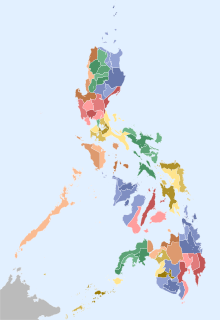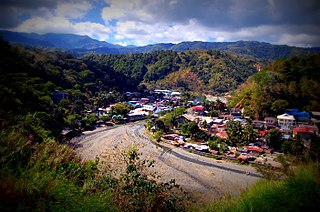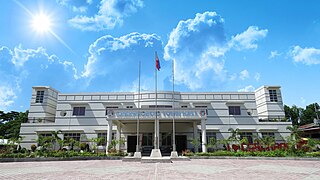
In the Philippines, provinces are one of its primary political and administrative divisions. There are 81 provinces at present, which are further subdivided into component cities and municipalities. The local government units in the National Capital Region, as well as independent cities, are independent of any provincial government. Each province is governed by an elected legislature called the Sangguniang Panlalawigan and an elected governor.

Cagayan Valley, designated as Region II, is an administrative region in the Philippines, located in the northeastern section of Luzon Island. It is composed of five Philippine provinces: Batanes, Cagayan, Isabela, Nueva Vizcaya, and Quirino. The region hosts four chartered cities of Cauayan, Ilagan, Santiago, and Tuguegarao.

Nueva Vizcaya is a landlocked province in the Philippines located in the Cagayan Valley region in Luzon. Its capital is Bayombong. It is bordered by Benguet to the west, Ifugao to the north, Isabela to the northeast, Quirino to the east, Aurora to the southeast, Nueva Ecija to the south, and Pangasinan to the southwest. Quirino province was created from Nueva Vizcaya in 1966.

Quirino is a landlocked province in the Philippines located in the Cagayan Valley region in Luzon. Its capital is Cabarroguis. It is named after Elpidio Quirino, the sixth President of the Philippines.

Bagabag, officially the Municipality of Bagabag, is a 2nd class municipality in the province of Nueva Vizcaya, Philippines. According to the 2015 census, it has a population of 35,501 people.

Kasibu, officially the Municipality of Kasibu, is a 3rd class municipality in the province of Nueva Vizcaya, Philippines. According to the 2015 census, it has a population of 37,705 people.

Kayapa, officially the Municipality of Kayapa, is a 3rd class municipality in the province of Nueva Vizcaya, Philippines. According to the 2015 census, it has a population of 23,714 people.

Santa Fe, officially the Municipality of Santa Fe, is a 3rd class municipality in the province of Nueva Vizcaya, Philippines. According to the 2015 census, it has a population of 16,180 people.

Cabarroguis, officially the Municipality of Cabarroguis, is a 3rd class municipality and capital of the province of Quirino, Philippines. According to the 2015 census, it has a population of 30,582 people.

Saguday, officially the Municipality of Saguday, is a 5th class municipality in the province of Quirino, Philippines. According to the 2015 census, it has a population of 16,070 people.

The legislative district of Mindanao and Sulu was the collective representation of the Department of Mindanao and Sulu and its component provinces of Agusan, Bukidnon, Cotabato, Davao, Lanao, Sulu and Zamboanga as a single at-large district in the lower house of the Philippine Legislature from 1916 until 1935.
The legislative districts of Ilocos Sur are the representations of the province of Ilocos Sur in the various national legislatures of the Philippines. The province is currently represented in the lower house of the Congress of the Philippines through its first and second congressional districts.

The legislative districts of Sultan Kudarat are the representations of the province of Sultan Kudarat in the various national legislatures of the Philippines. The province is currently represented in the lower house of the Congress of the Philippines through its first and second congressional districts.
The legislative districts of Isabela are the representations of the province of Isabela and the independent component city of Santiago in the various national legislatures of the Philippines. The province and the city are currently represented in the lower house of the Congress of the Philippines through their first, second, third, fourth, fifth, and sixth congressional districts.
The legislative district of Quirino is the representation of the province of Quirino in the various national legislatures of the Philippines. The province is currently represented in the lower house of the Congress of the Philippines through its lone congressional district.
The Kalanguya are an Austronesian ethnic group most closely associated with the Philippines' Cordillera Administrative Region, but whose core population can be found across an area which also includes the provinces of Nueva Vizcaya, Nueva Ecija, and Pangasinan. While this area spans Region I, the Cordillera Administrative Region, and Region II, it represents a largely geographically contiguous area.
The COVID-19 pandemic in Cagayan Valley is part of the worldwide pandemic of coronavirus disease 2019 caused by severe acute respiratory syndrome coronavirus 2. The virus reached Cagayan Valley on March 21, 2020, when the first case of the disease was confirmed in Tuguegarao. All provinces have confirmed at least one COVID-19 case, with Batanes being the last province to confirm a COVID-19 case on September 28, 2020.

Nueva Vizcaya's at-large congressional district, also known as Nueva Vizcaya's lone district, is the sole congressional district of the Philippines in the province of Nueva Vizcaya for various national legislatures since 1898. The province first elected its representative provincewide at-large for the Malolos Congress of the First Philippine Republic. In 1907 when the Philippine Assembly was established, the province had no representation as it then included parts of non-Christian tribelands. Since 1916 when it was re-established as a specially organized province separate from its former Comandancia de Quiañgan which became the Ifugao sub-province under Jones Law, Nueva Vizcaya has been entitled to one member in the House of Representatives. It remains as a single-member district, except for a brief period between 1943 and 1944 when a second seat was allocated in the National Assembly of the Second Philippine Republic.

The Nueva Vizcaya Provincial Board is the Sangguniang Panlalawigan of the Philippine province of Nueva Vizcaya.














